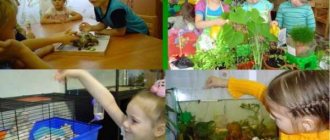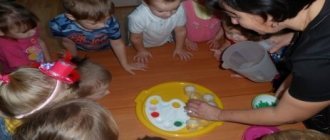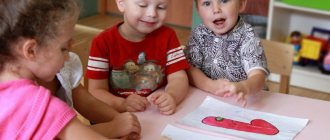Game as a leading activity for preschoolers
The game is one of the brightest and brightest memories of our childhood. Play is the main activity of a preschooler; it has a multifaceted impact on the child’s mental development. In it, children acquire new skills, abilities, and knowledge. Only in the game do you master the rules of human communication. Outside of play, the full moral and volitional development of a child cannot be achieved; outside of play, there is no personal development.
Preschool childhood is a large period of a child’s life. Living conditions at this time are rapidly expanding: the boundaries of the family are expanding to the limits of the street, city, and country. The child discovers the world of human relationships, different types of activities and social functions of people. He feels a strong desire to be involved in this adult life, to actively participate in it, which, of course, is not yet available to him. In addition, he strives no less strongly for independence. From this contradiction, role-playing game is born - an independent activity of children that models the life of adults. Role-playing or, as it is sometimes called, creative play appears in preschool age. This is an activity in which children take on the roles of adults and, in a general form, in play conditions, reproduce the activities of adults and the relationships between them. A child, choosing and playing a certain role, has a corresponding image - a mother, a driver, a pirate and patterns of his actions. The imaginative game plan is so important that without it the game simply cannot exist. But although life in play takes place in the form of ideas, it is emotionally rich and becomes his real life for the child.
At the end of early childhood, play with a plot “grows” out of object-manipulation activities. Initially, the child was absorbed in the object and actions with it. When he mastered the actions woven into joint activities with an adult, he began to realize that he was acting on his own and acting like an adult. In preschool age, affect is transferred from an object to a person, due to which the adult and his actions become a model not only objectively, but also subjectively.
Around the age of three, the child becomes much more independent, and his joint activities with a close adult begin to disintegrate. At the same time, the game is social both in origin and in content. She will not be able to develop without frequent, full-fledged communication with adults and without those varied impressions of the world around her, which the child also acquires thanks to adults. The child also needs various toys, including unformed objects that do not have a clear function, which he could easily use as substitutes for others.
At the border between early and preschool childhood, play with a plot first appears. This is a director's game we already know. Simultaneously with it or a little later, figurative role-playing appears. In it, the child imagines himself to be anything and everything and acts accordingly. But a prerequisite for the development of such a game is a vivid, intense experience: the child was struck by the picture he saw, and he himself, in his play actions, reproduces the image that evoked a strong emotional response in him.
Directed and figurative role-playing games become sources of plot-role-playing play, which reaches its developed form by the middle of preschool age. Later, games with rules emerge from it. It should be noted that the emergence of new types of games does not completely cancel old, already mastered ones - they are all preserved and continue to be improved. In role-playing games, children reproduce their own human roles and relationships. Children play with each other or with a doll as an ideal partner, who is also given a role.
Each game has its own playing conditions - the children, dolls, and other toys and objects participating in it. Their selection and combination significantly changes play in early preschool age; play at this time mainly consists of monotonously repeating actions reminiscent of manipulating objects.
The plot is the sphere of reality that is reflected in the game. At first, the child is limited to the family, and therefore his games are connected mainly with family and everyday problems. Then, as he masters new areas of life, he begins to use more complex plots - industrial, military, etc. The forms of play based on old stories, say in “mother-daughter” games, are also becoming more diverse. In addition, the game with the same plot gradually becomes more stable and longer. If at 3-4 years old a child can devote only 10-15 minutes to it, and then he needs to switch to something else, then at 4-5 years old one game can already last 40-50 minutes. Older preschoolers are able to play the same thing for several hours in a row, and some games last for several days.
Those moments in the activities and relationships of adults that are reproduced by the child constitute the content of the game. Younger preschoolers imitate object-based activities - cutting bread, grating carrots, washing dishes. They are absorbed in the process of performing actions and sometimes forget about the result - why and for whom they did it, the actions of different children are not consistent with each other, duplication and sudden changes in roles during the game are possible. For middle preschoolers, the main thing is the relationships between people; they perform play actions not for the sake of the actions themselves, but for the sake of the relationships behind them. For older preschoolers, it is important to obey the rules arising from the role, and the correctness of these rules is strictly controlled by them.
There are two main stages in the development of the game. The first stage (3-5 years) is characterized by the reproduction of the logic of people’s real actions; The content of the game is objective actions. At the second stage (5-7 years), real relationships between people are modeled and the content of the game becomes social relationships, the social meaning of an adult’s activity. As already mentioned, play is the leading activity in preschool age; it has a significant impact on the development of the child. First of all, in play, children learn to communicate with each other and the ability to establish certain relationships with peers.
Younger preschoolers do not yet know how to truly communicate with peers. Gradually, communication between children becomes more intense and productive. Play, especially collective play, requires the child to mobilize all his strengths and capabilities: both physical and mental. The game makes high demands on the development of a child’s speech: after all, he must explain what and how he would like to play, agree with other children who can play what role, pronounce his text so that others understand it. In middle and older preschool age, children, despite their inherent egocentrism, negotiate with each other, pre-distributing roles, as well as during the game itself. A meaningful discussion of issues related to roles and control over the implementation of the rules of the game becomes possible due to the inclusion of children in a common, emotionally rich activity for them.
The game contributes to the development of not only communication with peers, but also the child’s voluntary behavior. The mechanism for controlling one’s behavior—obedience to the rules—develops precisely in the game, and then manifests itself in other types of activities. Arbitrariness presupposes the presence of a pattern of behavior that the child follows and control. In the game, the model is not moral standards or other requirements of adults, but the image of another person whose behavior the child copies.
The game also develops the child’s motivational-need sphere. New motives for activity and goals associated with them arise.
In a developed role-playing game with its intricate plots and complex roles, creating a fairly wide scope for improvisation, children develop a creative imagination. The game contributes to the development of voluntary memory; it overcomes the so-called cognitive egocentrism. In general, the child’s position in the game radically changes. While playing, he acquires the ability to change one position to another, coordinate different points of view.
In preschool age, the main means of sensory education is considered to be didactic play. She is almost entirely entrusted with the task of forming the child’s sensory skills: familiarization with shape, size, color, space, sound. Didactic games as a game form of learning are a very complex phenomenon. In contrast to the educational essence of classes, in a didactic game two principles operate simultaneously: educational, cognitive, and playful, entertaining. In accordance with this, a parent or educator is at the same time a teacher and a participant in the game, teaches children and plays with them, and children learn by playing.
Problems of diagnosing the psychological readiness of preschoolers to study at school. The concept of "diagnosis". Features of diagnostic criteria for a child’s psychological readiness for school
The word “diagnosis” translated from Greek means the study of methods and principles of recognizing diseases and making a diagnosis, the process of making a diagnosis. The word “psychodiagnostics” literally means “making a psychological diagnosis,” or making a qualified decision about the current psychological state of a person as a whole or about any particular psychological property.
The term under discussion is ambiguous, and in psychology there are two understandings of it. One of the definitions of the concept “psychodiagnostics” refers it to a special area of psychological knowledge concerning the development and use in practice of various psychodiagnostic tools.
Psychodiagnostics in this understanding is a science in line with which the following general questions are posed:
1. What is the nature of psychological phenomena and the fundamental possibility of their scientific assessment?
2. What are the current general scientific foundations for the fundamental cognition and quantitative assessment of psychological phenomena?
3. To what extent do currently used psychodiagnostic tools comply with accepted general scientific and methodological requirements?
4. What are the main methodological requirements for various means of psychodiagnostics?
5. What are the grounds for the reliability of the results of practical psychodiagnostics, including the requirements for the conditions for conducting psychodiagnostics, the means of processing the results obtained and the methods of their interpretation?
6. What are the basic procedures for constructing and testing the scientific nature of psychodiagnostic methods, including tests?
The second definition of the term “psychodiagnostics” indicates a specific area of activity of a psychologist associated with the practical formulation of a psychological diagnosis. Here, not so much theoretical as purely practical issues related to the organization and conduct of psychodiagnostics are resolved.
It includes:
1. Determination of professional requirements for a psychologist as a psychodiagnostician.
2. Establishing a list of knowledge, skills and abilities that he must have in order to successfully cope with his work.
3. Clarification of the minimum practical conditions, the observance of which is a guarantee that the psychologist has truly successfully and professionally mastered one or another method of psychodiagnostics.
4. Development of programs, tools and methods for practical training of a psychologist in the field of psychodiagnostics, as well as assessment of his competence in this area.
Both sets of issues – theoretical and practical – are closely interconnected. In practice, psychodiagnostics is used in a variety of areas of activity of a psychologist: both when he acts as an author or participant in applied psychological and pedagogical experiments, and when he is engaged in psychological counseling or psychological correction. But most often, at least in the work of a practical psychologist, psychodiagnostics acts as a separate, completely independent field of activity. Its goal is to make a psychological diagnosis, i.e. assessment of a person’s current psychological state.
Scientific and practical psychodiagnostics solves a number of typical problems. These include the following:
1. Establishing whether a person has one or another psychological property or behavioral characteristic.
2. Determination of the degree of development of a given property, its expression in certain quantitative and qualitative indicators.
3. Description of the diagnosable psychological and behavioral characteristics of a person in cases where this is necessary.
4. Comparison of the degree of development of the studied properties in different people.
All four of the listed tasks in practical psychodiagnostics are solved either individually or comprehensively, depending on the goals of the examination. Moreover, in almost all cases, with the exception of a qualitative description of the results, proficiency in methods of quantitative analysis, in particular mathematical statistics, is required.
Psychodiagnostics is inextricably linked with the subject areas of psychological science: general psychology, medical, developmental, social, etc. The phenomena, properties and features studied by the listed sciences are measured using psychodiagnostic methods. The results of psychodiagnostic measurements can show not only the presence of a particular property, the degree of its expression, the level of development, they can also act as a way to verify the truth of theoretical and psychological constructs of various psychological directions.
Play activity
The leading activity is the game. Play is a form of activity in which a child reproduces the basic meanings of human activity and acquires those forms of relationships that he subsequently realizes and acts. It does this by replacing some objects with others, and real actions with abbreviated ones.
D.B. Elkonin argued that a game is a symbolic-modeling type of activity in which the operational and technical side is minimal, operations are reduced, and objects are conditional. It is well known that all types of activities of preschoolers are essentially modeling, and the essence of modeling is to recreate an object in another, non-natural material.
The subject of the game is an adult as a bearer of certain social functions, who enters into certain relationships with other people and follows certain rules in his activities.
In the game, an internal action plan is formed. It goes like this. A child at play is focused on human relationships. To reflect them, he must internally reproduce not only the entire system of actions, but also the entire system of consequences of these actions, and this is only possible when forming an internal plan of action.
As shown by D.B. Elkonin, play is a historical education, and it arises when a child cannot participate in the social work system because he is still too small for this. But he wants to enter adulthood, so he does it playfully, making some contact with this life.
The main components of a role-playing game:
Plot is a series of events taking place in a given area. For example, the game “family”, “doctor”, “store”. The main source for the game plot is the surrounding world, the activities of adults and peers, plots from books, cartoons and films (playing Iron Man, Winx Fairies, etc.). The variety of plots increases as the child becomes acquainted with new aspects of life. The plot reveals the content of the game.
The content of the game is what children highlight as the main point of activity and relationships between the participants in the plot, i.e. those actions that people (characters) perform in certain life situations. For example, a “mom” goes to the store to buy groceries, where she selects the products, puts them in a cart, pays the “salesperson” at the checkout, etc.
A role is a set of models and actions that are played out by children in the plot.





